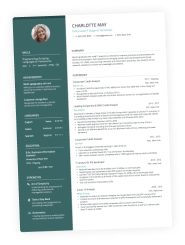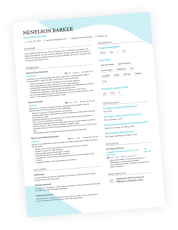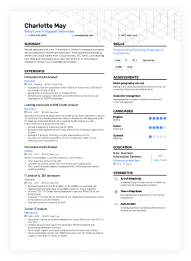One of the main purposes of a CV, simply, is that it’s a document highlighting why you’re the best fit for your next job. Toward that end, great CV job descriptions are pivotal in conveying your qualifications and abilities to potential employers, compelling them to call you for an interview.
If you want to beat the competition for the best and most desirable jobs, you have to include the right info in the right way. Including the wrong items or too much information could lessen, or worse, lose you the chance at the job of your dreams.
To help you navigate the do’s and don’ts of this CV essential, we’re covering everything you need to craft exceptional CV job descriptions. In this article, we’ll cover:
- What job descriptions are, and why you need to include them
- How action verbs and measurable results can dramatically improve your CV
- We’re going step-by-step into how to write and edit the perfect CV job description
- And we’ve included three examples of impeccable job descriptions you can use to guide your own
What are job descriptions and why include them?
A job description on a CV concisely summarises a person's past employment roles, outlining the key responsibilities, accomplishments, and the key skills relevant to each position. Using action verbs that grab attention and including measurable results where they apply are great ways to boost your CV’s impact and grab recruiters’ attention.
A job description is important because it provides a structured and concise overview of a candidate's work history that lets employers easily gauge their fit. Efficiently communicating this info is vital in a competitive job market to increase your chances of being considered for a position and moving onto the interview stage.
Using action verbs and measurable results
Incorporating action verbs and measurable results adds impact and credibility to your job descriptions. They make your CV more compelling to recruiters and could make the difference between moving on to the next hiring stage.
Here’s what you need to know about them.
Action verbs
A simple hack to boost the impact of your job description is to use dynamic action verbs that emphasise your active role in previous work experiences. Use them to start sentences or peppered sparingly in the job descriptions to describe specific achievements, tasks, or responsibilities you accomplished.
Action verbs effectively convey a proactive approach to work and demonstrate initiative, leadership, and results. They make your accomplishments more engaging and showcase your readiness for professional responsibilities, helping capture recruiters’ attention.
Some strong action verbs to consider using in job descriptions include:
- Analysed
- Managed
- Implemented
- Led
- Developed
- Resolved
- Increased
- Created
- Spearheaded
- Coordinated
- Executed
- Facilitated
- Streamlined
Measurable results
Including measurable results on your CV means quantifying achievements and accomplishments in specific terms to demonstrate their tangible impact. It adds credibility and demonstrates your ability to produce measurable results, helping you sell yourself to a potential employer.
Your concrete successes give prospective employers a clearer picture of your contributions and their direct impact on the organisation. Showcasing these can be a powerful motivator for a recruiter looking to lock in the best candidate for their role.
How to use action verbs and measurable results
Not convinced? Compare the examples we’ve included here to see how a job description entry describing the same experience using active verbs and measurable results is far more effective and interesting than using a passive tone.
Example 1
Active and quantified
Managed a team of 10 sales representatives, generating a 25% monthly revenue increase.
Passive
Responsible for 10 sales representatives
The active version explicitly states the candidate's direct action in leading the team, making it more engaging and highlighting their leadership role. It also shows how effective they were as a leader by indicating the specific increase in revenue their actions had.
Example 2
Active and quantified
Developed and implemented a cost-saving strategy, resulting in annual savings of £50,000.
Passive
Participated in the development and implementation of a successful cost-saving strategy.
The active phrasing emphasises the candidate's active role in developing and implementing the strategy, showcasing their initiative. Including their strategy's impact showcases their effectiveness in the role and clarifies their value to the new employer beyond simply saying it was a success.
Example 3
Active and quantified
Designed and executed a marketing campaign, doubling website traffic within three months.
Passive
Contributed to the design and execution of a marketing campaign that increased website traffic.
The active version clearly attributes the design and execution of the campaign to the candidate, highlighting their direct involvement and accountability for the outcome. And again, the specific measured results are a more powerful indicator of the candidate’s value than the vague success of increased site visits.
What to include in your job description
Because of the unique set of experiences you’ve had, and since you’ll want to tailor your CV for each application, the exact content of a job description on any given CV will vary. But there are specific elements you always want to include for each entry:
Job title, company, and location
Clarity in job titles, company name, and where you were working is the most basic and crucial info to include in your CV job descriptions. It helps potential employers quickly grasp your professional background and removes any confusion about where you worked.
You can list this information in different ways depending on the style and CV formatting you’ve chosen. Regardless, maintaining consistency in font and style throughout the document and using bold and italics sparingly for emphasis guarantees the greatest readability and aesthetic appeal.
Employment dates
Accurate employment dates are a cornerstone of a well-structured CV. They provide a clear timeline of your professional history, helping potential employers understand your career progression.
Inconsistencies or inaccuracies can raise doubts about your reliability and attention to detail, so ensure your dates align with your work history. When dealing with employment gaps or short-term positions, honesty is the best policy.
Address any gaps by explaining the circumstances briefly but truthfully, showing how you used that time constructively or how it contributed to your skills. Transparency in handling these aspects reflects professionalism and integrity to prospective employers.
Key responsibilities, achievements, and accomplishments
Listing key responsibilities on a CV effectively involves using action verbs to describe tasks and duties clearly and concisely. As we saw earlier, start each bullet point with a strong action verb, such as "managed," "developed," or "implemented," to convey an active role.
Also, be sure to describe your specific achievements and accomplishments, such as revenue increases, cost savings, or improved efficiency. This approach demonstrates your impact and helps recruiters gauge your potential value to their organisation.
Tailoring job descriptions
Customising job descriptions on your CV for each job application is crucial when facing stiff competition. Tailoring means aligning your listed responsibilities and achievements with the specific job requirements you're applying for.
A tailored approach demonstrates to potential employers that you've carefully considered how your skills and experience match their needs. It makes your application more relevant and increases the chances of getting noticed.
While it requires some extra effort, tailoring your job descriptions can significantly enhance your chances of landing the job you’re aiming for. This approach is compelling to recruiters since it shows your proven track record of delivering relevant, tangible benefits.
Keywords and ATS
Incorporating relevant keywords for Applicant Tracking Systems (ATS) on a CV is essential for increasing the chances of your CV getting noticed by employers. ATS scan CVs for specific keywords related to the job, so it's important to include terms directly linked to your industry, skills, and qualifications.
However, it's equally important to balance keyword optimisation, readability, and authenticity. Overloading your CV with keywords at the expense of clear and concise language can make it less reader-friendly and may come across as insincere or tacky.
Aim to naturally integrate keywords into your CV, ensuring it remains well-organised and authentic, reflecting your actual skills and experiences. This way, you can navigate the ATS while delivering a compelling and genuine CV that appeals to hiring managers and that you can support honestly in an interview.
Length and conciseness
Finding the right balance between providing sufficient detail and being concise in a job description on a CV is imperative but can seem tricky. To achieve this balance, consider these tips for trimming unnecessary information:
- Focus on relevant information: Include details directly related to the job you're applying for. Highlight responsibilities and achievements that showcase your skills and qualifications for that specific role.
- Prioritise recent roles: Give more space and detail to your most recent positions. Older roles can be summarised with less detail if they’re less relevant to your current career goals.
- Use bullet points: Present your responsibilities and accomplishments in 3-5 bullet points for each job in most cases Keep each point concise and to the point.
- Omit redundant data: Avoid repeating similar responsibilities for different roles. If a task was common across multiple jobs, mention it once and specify the impact or results achieved.
- Remove irrelevant experience: If you have work experience that doesn't contribute to your qualifications for the job you're seeking, consider omitting it altogether. Even so, irrelevant jobs are better than a gap, so choose the best option in your case.
- Quantify achievements: Emphasise measurable achievements where possible, as they provide more value in fewer words.
- Avoid jargon: Use clear and straightforward language instead of industry-specific jargon, making your CV more concise and accessible.
- Edit, edit, edit: Review your CV critically and remove any information that doesn't directly support your application. Be ruthless in cutting out unnecessary details.
Follow these tips to craft a job description that strikes the right balance between providing enough detail to showcase your qualifications and keeping it concise and reader-friendly. This approach ensures potential employers can quickly grasp your suitability for the position.
Keeping it honest and authentic
No matter your experience level or what happened in the past, maintaining honesty and authenticity on your CV is paramount. It builds trust and credibility with potential employers.
Exaggerations or misrepresentations undermine your integrity and can lead to severe repercussions if discovered during the hiring process or later in your career.
By accurately portraying your responsibilities and achievements, you give employers a realistic preview of your qualifications. This helps find the right fit between your skills and the job requirements, leading to more meaningful and sustainable career opportunities.
Avoiding common mistakes
To present yourself professionally, avoid common mistakes in your CV job descriptions. Common errors to watch out for include:
- Vague language: Avoid using vague terms like "assisted with" or "worked on." Be specific about your contributions.
- Grammatical errors: Carefully proofread for grammar and spelling mistakes, as they can detract from your professionalism.
- Overusing buzzwords: While action verbs are important, don't overuse cliché terms like "team player" or "detail-oriented." Use them sparingly and when they genuinely apply.
- Lack of quantification: Quantify achievements whenever possible to provide concrete evidence of your impact.
- Being too lengthy: Keep job descriptions concise and focused on the most relevant information. Avoid overly long paragraphs.
- Omitting key information: Include all relevant job responsibilities and achievements without omitting important details.
Get feedback, proofread, and edit
Seek feedback and follow a structured review process to improve your job descriptions. This formula will ensure you create a compelling CV that effectively communicates your qualifications and experiences to potential employers.
Feedback from peers or professional mentors is invaluable. They offer an outside perspective that can help you refine your job descriptions effectively in a few ways:
First, peers and mentors may identify weak spots and areas of improvement you might have overlooked, like unclear language, wordiness, or missing details. They can highlight aspects that need more emphasis or suggest better action verbs to make your descriptions more impactful.
Second, their feedback helps ensure alignment with industry standards and employer expectations. Professional mentors, especially those with experience in your field, can guide you on which accomplishments to emphasise and which responsibilities to focus on.
Finally, their feedback will also help you with error detection. They can catch grammatical mistakes or typos you might have missed, ensuring your CV is as polished and professional as possible.
Follow these steps to review and edit your job descriptions effectively:
- Review multiple times: Go over your CV several times, checking for different aspects such as grammar, clarity, and relevance.
- Grammar and spell-check: Use digital and online tools to catch common grammatical and spelling errors.
- Read aloud: Read your descriptions aloud to identify awkward phrasing and errors you might overlook when reading silently.
- Clarity and conciseness: Ensure your descriptions are clear, concise, and focused on relevant information. If it’s not clear, rephrase. If you’ve said before, cut it.
- Peer review: Share your CV with peers or mentors and ask for their honest opinions and suggestions.
- Incorporate feedback: Feedback is pointless if you don’t consider it or use it. Be humble, think about the feedback, and incorporate what you feel would improve your CV.
Once you’ve gone through and incorporated feedback, go through steps 1-4 again to be sure it all works together and that you caught any new mistakes you might have added. Being vigilant to avoid common mistakes and using these effective editing techniques will guarantee your CV is polished, error-free, and professionally presented.
Putting it all together
Look over these three example job description entries we’ve made targeting different fields that implement the rules and suggestions we covered in this article. They showcase achievements and responsibilities tailored to different fields and roles, highlighting the candidate's impact and contributions.
Use them as a guide to craft your own amazing job descriptions!
Example 1
Marketing Manager,
InnovateTech Ltd, London
2018-2021
- Developed and executed comprehensive marketing strategies, resulting in a 40% increase in online lead generation and a 25% boost in annual revenue.
- Managed a cross-functional team of 8 members to successfully launch a product line, achieving a 15% market share within the first year.
- Analysed market trends and competitor data to inform decision-making, leading to the creation of customer-centric campaigns that increased brand loyalty by 20%.
Example 2
Senior Software Engineer, Quantum Finance Solutions, Liverpool
2017-2022
- Designed and implemented scalable software solutions, reducing processing time by 30% and enhancing overall system performance.
- Led a team of 6 developers in agile project management, resulting in the timely delivery of multiple critical projects, earning accolades from clients.
- Collaborated with the Quality Assurance team to establish rigorous testing protocols, reducing post-release bug reports by 40%.
Example 3
Registered Nurse, Hillside General Hospital, Sheffield
2016-2020
- Delivered compassionate and high-quality patient care in a fast-paced surgical ward, maintaining a 95% patient satisfaction rating.
- Acted as the lead nurse during emergencies, coordinating response efforts and ensuring efficient patient triage, contributing to a 25% reduction in critical incidents.
- Collaborated with the healthcare team to implement best practices, resulting in a 15% decrease in post-surgical complications and a 10% improvement in patient outcomes.
Takeaways
- Job descriptions are the foundation of your CV.
- Always include your job title, the name of the company you worked at, and your employment dates.
- Use active verbs and measurable results to boost your CV’s impact.
- Balance the details you include with being concise.
- Include the most relevant details for the job you’re applying to.
- Honesty is important for long-term job success.



